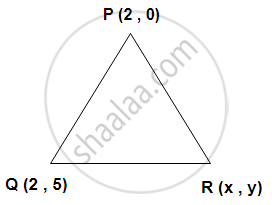Advertisements
Advertisements
प्रश्न
PQR is an isosceles triangle . If two of its vertices are P (2 , 0) and Q (2 , 5) , find the coordinates of R if the length of each of the two equal sides is 3.
उत्तर

PQ = c
∴ PR = QR = 3 units
Let the coordinates of R be on ,
PR = `sqrt (("x" - 2)^2 + ("y" - 0)^2)`
`=> 3 = sqrt ("x"^2 + 4 - 4"x" + "y"^2)`
squaring both sides ,
`=> 9 = "x"^2 - 4"x" + "y"^2 + 4`
`=> "x"^2 - 4"x" + "y"^2 - 5 = 0`
`=> "x"^2 + "y"^2 - 4"x" = 5` .....(1)
QR = `sqrt (("x" - 2)^2 + ("y" - 5)^2)`
`=> 3 = sqrt ("x"^2 + 4 - 4"x" + "y"^2 + 25 - 10"y")`
⇒ 9 = x2 + y2 - 4x - 10y + 29
⇒ 0 = x2 + y2 - 4x - 10y + 29
From (1) 0 = 5 - 10y + 20
10 y = 25
y = `5/2`
`=> "x"^2 + 25/4 - 4"x" - 5 = 0`
`=> 4"x"^2 + 25 - 16"x" - 20 = 0`
`=> 4"x"^2 - 16"x" + 5 = 0`
D = (-16)2 - 4(4)(5)
= 256 - 80
= 176
`sqrt "d" = sqrt 176 = 4 sqrt 11`
x = `(16 +- 4 sqrt 11)/(2 xx 4)`
= `(4 +- 4 sqrt 11)/2`
= `2 + sqrt 11/2 , 2 - sqrt 11/2`
The coordinates of R are `(2 - sqrt 11/2 , 5/2)` or `(2 + sqrt 11/2 , 5/2)`
APPEARS IN
संबंधित प्रश्न
Find a relation between x and y such that the point (x, y) is equidistant from the point (3, 6) and (−3, 4).
If the distances of P(x, y) from A(5, 1) and B(–1, 5) are equal, then prove that 3x = 2y
If the point P(x, y ) is equidistant from the points A(5, 1) and B (1, 5), prove that x = y.
Find the value of a if the distance between the points (5 , a) and (1 , 5) is 5 units .
Prove that the points (1 , 1) , (-1 , -1) and (`- sqrt 3 , sqrt 3`) are the vertices of an equilateral triangle.
A point P lies on the x-axis and another point Q lies on the y-axis.
Write the abscissa of point Q.
A point P lies on the x-axis and another point Q lies on the y-axis.
If the abscissa of point P is -12 and the ordinate of point Q is -16; calculate the length of line segment PQ.
Find the distance of the following points from origin.
(5, 6)
Find distance between points O(0, 0) and B(– 5, 12)
Show that the points (0, –1), (8, 3), (6, 7) and (– 2, 3) are vertices of a rectangle.
